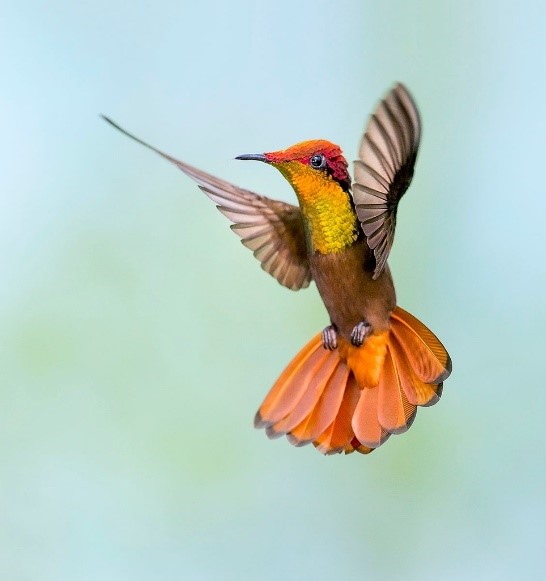Birdfinding.info ⇒ This radiant article of avian jewelry is locally common in several portions of its extensive range, especially in the southern Caribbean and northeastern Brazil. On Aruba it is especially common around Spaans Lagoon. On Tobago and northern Trinidad it is easy to find at several ecolodges that maintain hummingbird feeders, including those at Cuffie River Nature Retreat, Adventure Farm, Speyside, Yerette, and Asa Wright Nature Center. In northern Colombia it attends the feeders at Jardin Encantado near Bogotá, among other places. It Brazil it is one of the predominant hummingbirds of the northeast and widely distributed but somewhat uncommon and local elsewhere. Popular sites where it occurs reliably include Boa Nova (Bahia) and Santa Teresa (Espírito Santo).
Ruby-topaz Hummingbird
Chrysolampis mosquitus
Northern and eastern South America and the southern Caribbean.
Occurs in savannas, brushland, and forest borders from easternmost Panama eastward across northern and eastern Colombia, most of Venezuela, the Guianas, and eastern Amazonia to the Atlantic Coast of Brazil, and south to eastern Bolivia, Mato Grosso do Sul, São Paulo, and Rio de Janeiro.
Appears to be spreading west across southern Amazonia following the frontier of deforestation.

Brazilian records from © WikiAves
In the Caribbean it occurs on the ABC Islands, many of Venezuela’s offshore islands, Trinidad, and Tobago. On some of the smaller and drier islands, it is the only resident hummingbird.
At least partly migratory or nomadic as it is present only seasonally or sporadically in many areas, but its movements are not well documented or understood.
Identification
A medium-to-small hummingbird with a proportionately long, broad, rufous tail and a long, nearly straight bill.

Ruby-topaz Hummingbird, male. (Dorp Rincón, Bonaire; August 12, 2018.) © Gérard Cachon
Male appears largely blackish in poor light, but when seen clearly it is mostly brown above and below with three large patches of color: the crown gleams ruby-red; the throat is bright orange (but appears greenish in some lighting); and the tail and undertail coverts can appear rufous, bronze, orange, or red, with a thin dark terminal band.
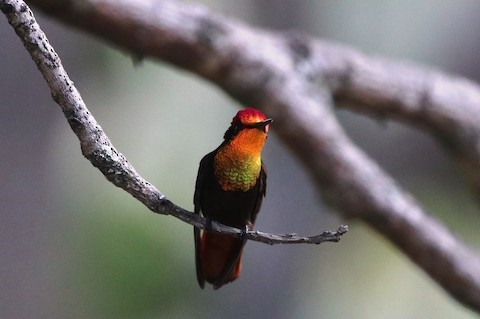
Ruby-topaz Hummingbird, male. (St. Augustine, Trinidad; May 7, 2019.) © Jason Fidorra

Ruby-topaz Hummingbird, male. (Tobago; January 22, 2009.) © Geoffrey Einon

Ruby-topaz Hummingbird, male. (Asa Wright Nature Centre, Trinidad; January 17, 2017.) © Kamal Mahabir

Ruby-topaz Hummingbird, male showing only orange irisdescence. (Yerette, Trinidad; February 27, 2017.) © Jerome Foster

Ruby-topaz Hummingbird, male. (Praça dos Cristais, Brasília, Brazil; November 19, 2016.) © Rodrigo Conte
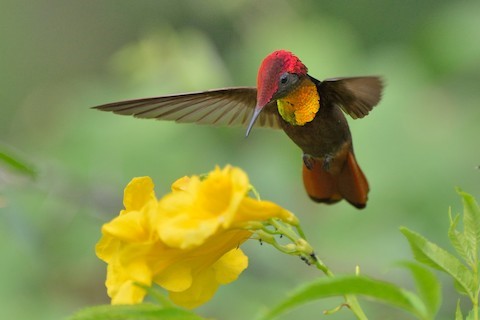
Ruby-topaz Hummingbird, male. (Spaans Lagoon, Aruba; December 6, 2018.) © Michiel Oversteegen

Ruby-topaz Hummingbird, male. (Spaans Lagoon, Aruba; July 19, 2019.) © Michiel Oversteegen
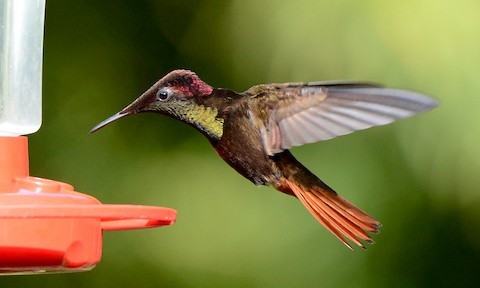
Ruby-topaz Hummingbird, male. (Moriah, Tobago; February 14, 2017.) © Erik Martin
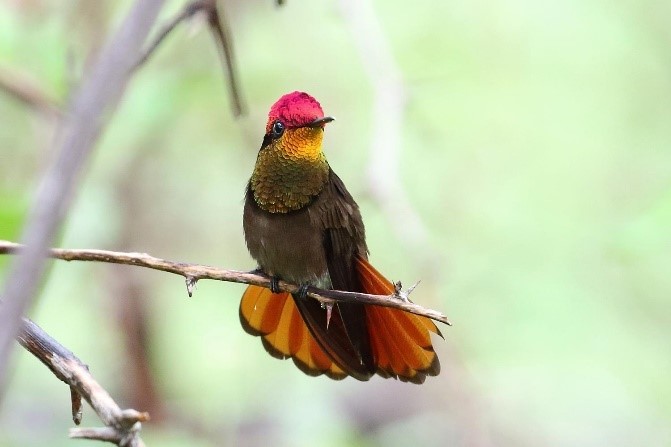
Ruby-topaz Hummingbird, male. (Boa Nova, Bahia, Brazil; December 8, 2017.) © Megan Perkins

Ruby-topaz Hummingbird, male. (Asa Wright Nature Centre, Trinidad; June 16, 2018.) © Chris Rohrer
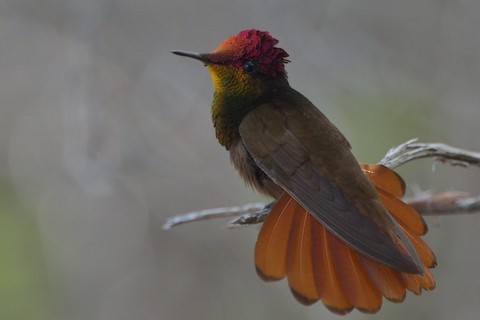
Ruby-topaz Hummingbird, male. (Spaans Lagoon, Aruba; October 7, 2016.) © Michiel Oversteegen
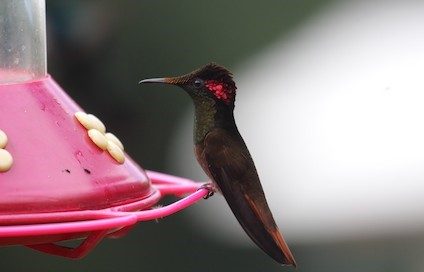
Ruby-topaz Hummingbird, male in low light, showing minimal iridescence. (Jardin Encantado, Cundinamarca, Colombia; January 6, 2018.) © Paul van Els
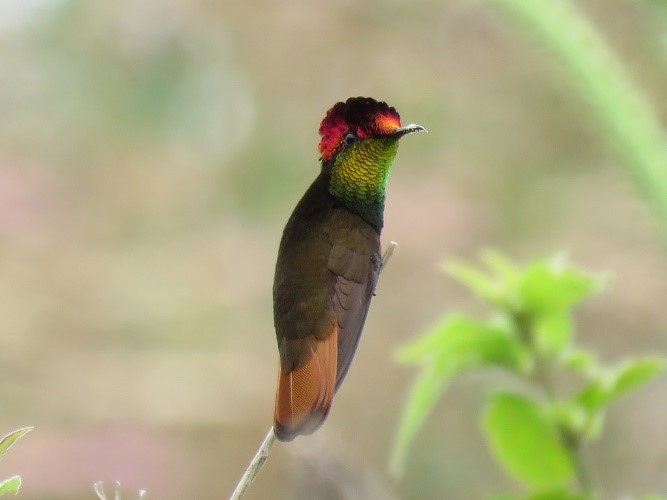
Ruby-topaz Hummingbird, male showing greenish cast on throat. (Yopal, Casanare, Colombia; October 3, 2018.) © Nicolas Olejnik
The male’s crown feathers extend far forward over the bill, giving its forehead a long, shallow slope, and making its bill appear short (except when seen in full profile).
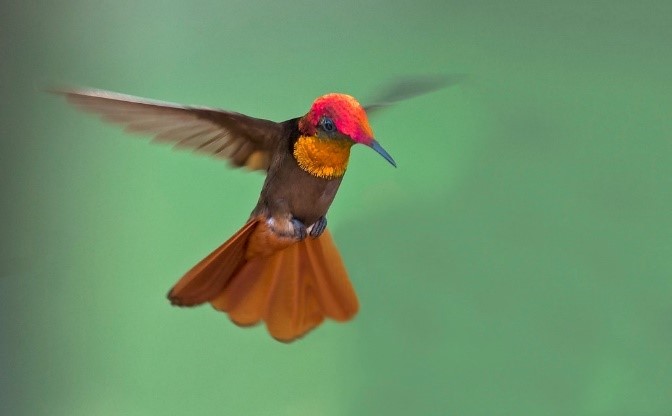
Ruby-topaz Hummingbird, male. (Cali, Colombia; April 8, 2016.) © Juan José Arango
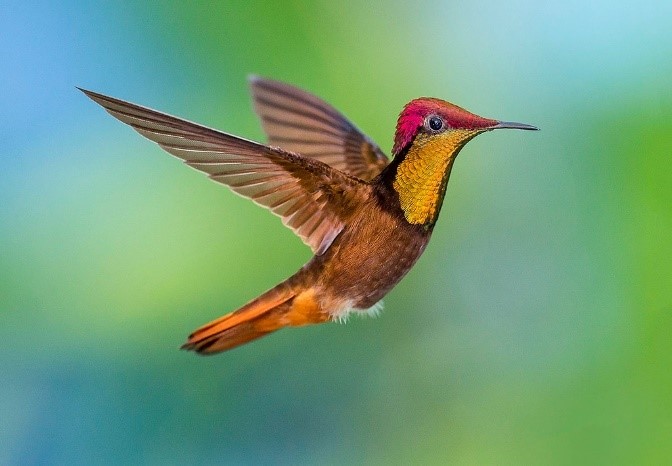
Ruby-topaz Hummingbird, male. (Asa Wright Nature Centre, Trinidad; January 25, 2018.) © Pedro Lastra

Ruby-topaz Hummingbird, male. (Asa Wright Nature Centre, Trinidad; March 23, 2017.) © Pedro Lastra
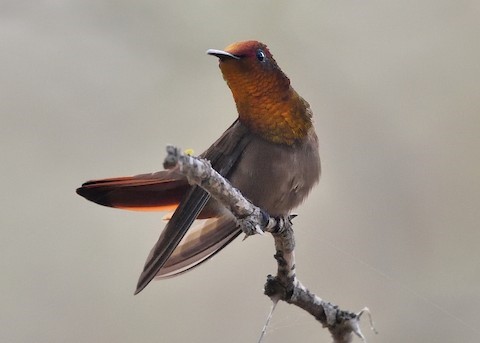
Ruby-topaz Hummingbird, male. (Spaans Lagoon, Aruba; March 12, 2019.) © Michiel Oversteegen
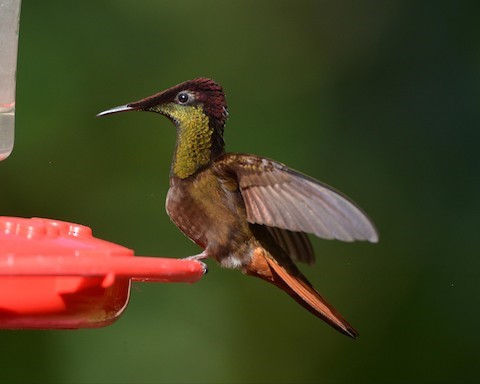
Ruby-topaz Hummingbird, male showing feathering that extends far out onto the bill. (Cuffie River Nature Retreat, Mount Dillon, Tobago; January 23, 2018.) © Sharon Lynn

Ruby-topaz Hummingbird, male. (Asa Wright Nature Centre, Trinidad; March 8, 2018.) © Pedro Lastra

Ruby-topaz Hummingbird, male. (Asa Wright Nature Centre, Trinidad; March 12, 2018.) © Pedro Lastra
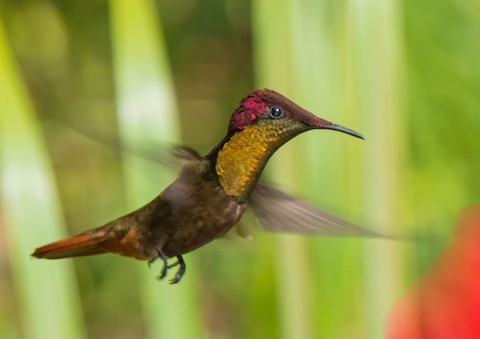
Ruby-topaz Hummingbird, male. (Yerette, Trinidad; April 26, 2014.) © William Stephens
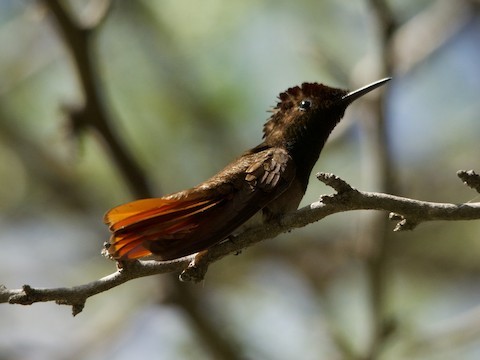
Ruby-topaz Hummingbird, male in low light. (Spaans Lagoon, Aruba; February 6, 2018.) © Michael Tromp

Ruby-topaz Hummingbird, male showing limited iridescence. (Spaans Lagoon, Aruba; April 26, 2018.) © Michael Tromp
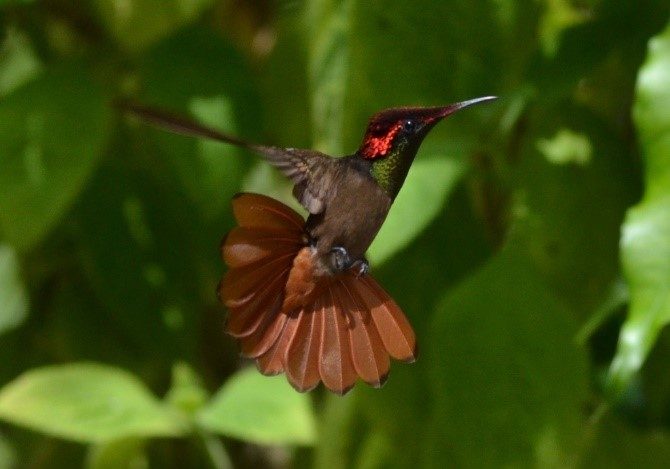
Ruby-topaz Hummingbird, male showing ruby crown and greenish throat. (Maracas, Trinidad; March 19, 2019.) © ha33

Ruby-topaz Hummingbird, male showing limited iridescence. (Spaans Lagoon, Aruba; March 12, 2019.) © Michiel Oversteegen
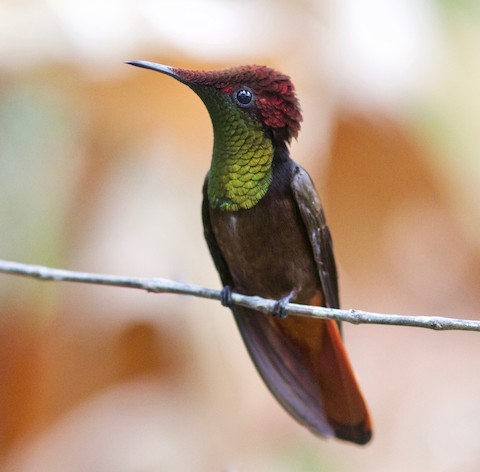
Ruby-topaz Hummingbird, male showing greenish cast on throat. (Speyside, Tobago; June 15, 2017.) © Andre Moncrieff

Ruby-topaz Hummingbird, male. (Bubali Bird Sanctuary, Aruba; July 25, 2016.) © Michiel Oversteegen
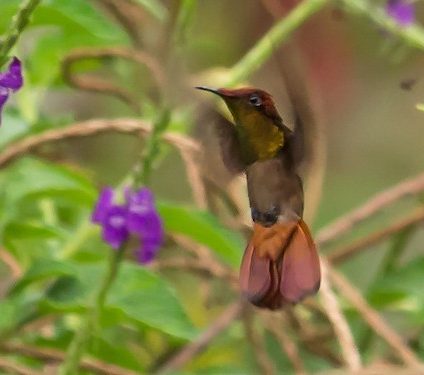
Ruby-topaz Hummingbird, male showing limited iridescence. (Canopy Camp, Meteti, Darién, Panama; March 23, 2016.) © Carol Rose
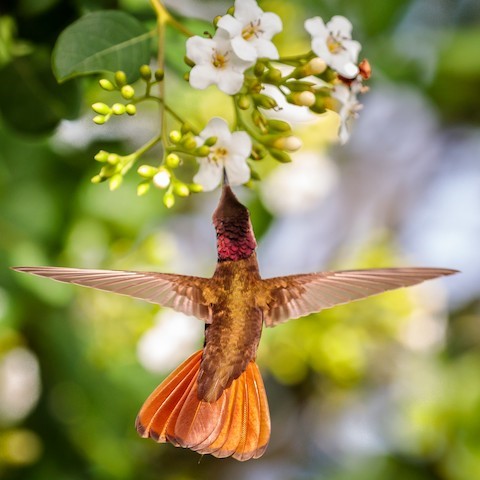
Ruby-topaz Hummingbird, male, dorsal view. (Dorp Rincón, Bonaire; August 12, 2018.) © Gérard Cachon
Female plumage is plain overall, with brownish upperparts and whitish underparts.
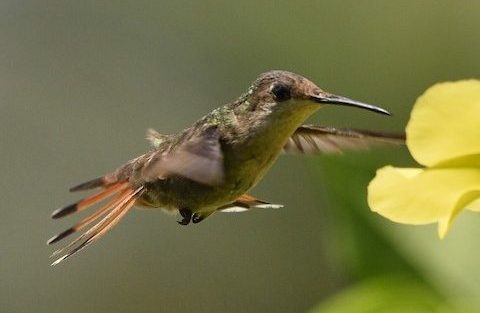
Ruby-topaz Hummingbird, female. (Moko, Aruba; March 17, 2019.) © Michiel Oversteegen
When spread, the female’s tail is largely rufous with a wide black subterminal band and white tips on the outer feathers. When closed, the tail’s rufous patches are not visible.

Ruby-topaz Hummingbird, female showing rufous-and-black tail pattern—note that the rufous in the undertail coverts here appears to be a trick of the light. (Dorp Rincón, Bonaire; August 12, 2018.) © Gérard Cachon

Ruby-topaz Hummingbird, female. (Fazenda Javaes, Pium, Tocantins, Brazil; August 5, 2011.) © Josep del Hoyo

Ruby-topaz Hummingbird, female, ventral view. (Spaans Lagoon, Aruba; September 4, 2017.) © Michiel Oversteegen

Ruby-topaz Hummingbird, female, dorsal view. (Spaans Lagoon, Aruba; March 12, 2019.) © Michiel Oversteegen

Ruby-topaz Hummingbird, female, dorsal view. (Spaans Lagoon, Aruba; March 12, 2019.) © Michiel Oversteegen
Immature males resemble females, but usually show some dark or iridescent feathering on the crown and throat.

Ruby-topaz Hummingbird, immature male. (Spaans Lagoon, Aruba; January 24, 2017.) © Michiel Oversteegen

Ruby-topaz Hummingbird, immature male. (Spaans Lagoon, Aruba; July 10, 2019.) © Michiel Oversteegen

Ruby-topaz Hummingbird, immature male. (Asa Wright Nature Centre, Trinidad; March 25, 2015.) © Pedro Lastra

Ruby-topaz Hummingbird, immature male. (Arnos Vale, Tobago; July 23, 2008.) © Nathan Kamphof
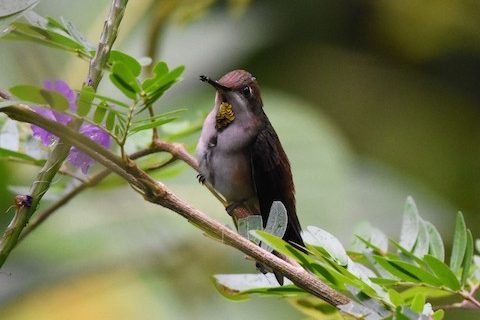
Ruby-topaz Hummingbird, immature male. (Asa Wright Nature Centre, Trinidad; June 16, 2018.) © Chris Rohrer

Ruby-topaz Hummingbird, immature male. (Trinidad; March 18, 2013.) © Roger Forster
Voice. Common call is a liquid tsip! usually repeated several times in fairly rapid succession:
Notes
Monotypic species and genus. Sometimes known simply as the Ruby Topaz.
References
Ascanio, D., G.A. Rodriguez, and R. Restall. 2017. Birds of Venezuela. Christopher Helm, London.
BirdLife International 2016. Chrysolampis mosquitus. The IUCN Red List of Threatened Species 2016: e.T22687160A93142952. http://dx.doi.org/10.2305/IUCN.UK.2016-3.RLTS.T22687160A93142952.en. (Accessed August 18, 2019.)
eBird. 2019. eBird: An online database of bird distribution and abundance. Cornell Lab of Ornithology, Ithaca, N.Y. http://www.ebird.org. (Accessed August 18, 2019.)
ffrench, R. 2012. A Guide to the Birds of Trinidad & Tobago (Third Edition). Cornell University Press. Ithaca, N.Y.
Fogden, M., M. Taylor, and S.L. Williamson. 2014. Hummingbirds: A Life-size Guide to Every Species. HarperCollins, New York.
McMullan, M., and T. Donegan. 2014, Field Guide to the Birds of Colombia (Second Edition). Fundación Proaves de Colombia, Bogotá.
Ridgely, R.S., and J.A. Gwynne. 1989. A Guide to the Birds of Panama (Second Edition). Princeton University Press, Princeton, N.J.
Schuchmann, K.L., and G.M. Kirwan. 2019. Ruby-topaz Hummingbird (Chrysolampis mosquitus). In Handbook of the Birds of the World Alive (J. del Hoyo, A. Elliott, J. Sargatal, D.A. Christie, and E. de Juana, eds.). Lynx Edicions, Barcelona. https://www.hbw.com/node/55413. (Accessed August 18, 2019.)
van Perlo, B. 2009. A Field Guide to the Birds of Brazil. Oxford University Press, Oxford.
Wells, J.V., and A.C. Wells. 2017. Birds of Aruba, Bonaire, and Curaçao. Cornell University Press, Ithaca, N.Y.
Wikiaves, Beija-flor-vermelho, https://www.wikiaves.com.br/wiki/beija-flor-vermelho.
